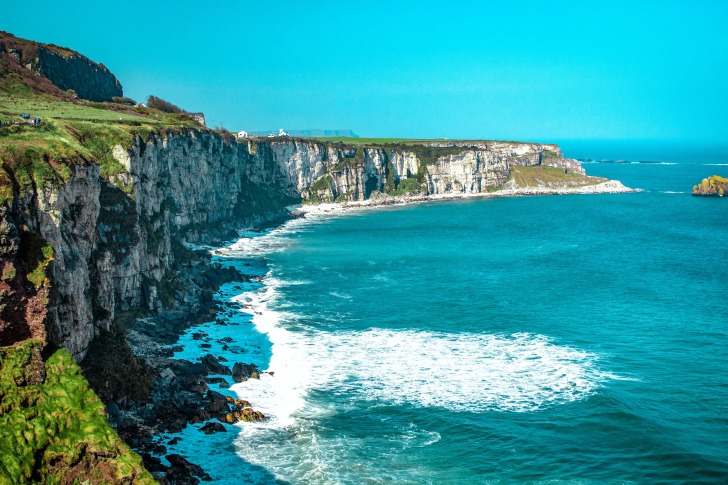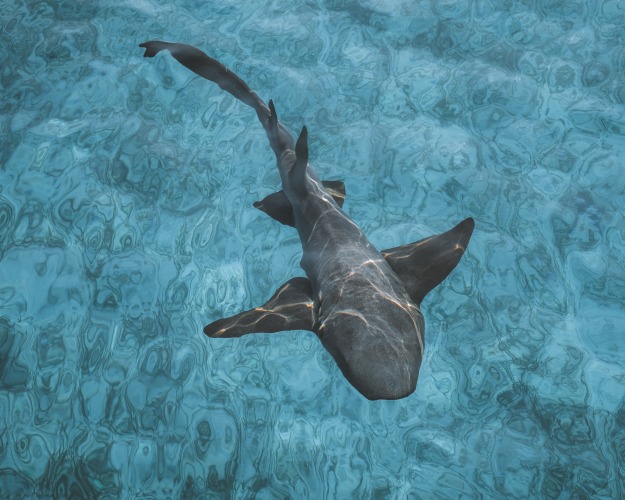100s of shark species are located in oceans across the globe.
Some are as large as great whites, while others are as small as sand sharks.
Given that they are apex predators of the ocean, they can deal humans severe injuries and even death.
On the other hand, sharks play a significant role in local sea life ecosystems by being an indicator of ocean health and maintaining the species below them.
They remove the sick and weak while keeping the balance with competitors to ensure diversity.
If you’ve visited Ireland, you may think there are no sharks in the surrounding waters, but is that true?
Keep reading to find out!
Contents
So… Are There Sharks in Ireland?
Contrary to popular belief, approximately 35 shark species have been found in the waters around Ireland, including the second largest fish in the sea, the basking shark!
While many areas of Ireland are rocky with cliffs that drop into the ocean, there are beaches residents visit in the summer.
However, like in most other regions of the world, shark attacks are highly uncommon as there other more realistic precautions that must be taken.

While there are 35 sark species in Ireland, the most exciting include:
Basking Shark
As the world’s second-largest living fish and shark, the basking shark is one of only three plankton-eating species with the megamouth and whale sharks.
Adult males can grow up to 36 feet or more in length.
This shark is the gentle giant of the sea, only eating plankton!
Blue Shark
The blue shark derives its name from having a beautiful and elegant metallic blue back, which delivers incredible camouflage in the open ocean.
These are common in the Irish seas during the summer months, having traveled from the Caribbean through the Gulf Stream.
Nursehound
The nursehound doesn’t look like a traditional shark but more like a catfish.
This nocturnal predator hunts smaller fish close to the seafloor and boasts brown skin with black dots to help with camouflage.
Porbeagle Shark
The Porbeagle shark is part of the Lamnidae family, making it a close relative of the great white shark.
This shark type is most commonly found in deeper waters where it hunts small fish, including herring, whiting, and mackerel, as well as cuttlefish, squid, and octopus.
Small-Spotted Catshark
Formerly known as the lesser-spotted dogfish, the catshark is a small species covered in dark spots for protection.
While all sharks have rough skin, the catshark has dermal denticles and tiny skin teeth that feel like sandpaper.
It offers the shark adequate chain-mail protection.
Spurdog Shark
The spurdog shark derives its name from the spines on the front of its dorsal fin.
This shark uses its spines to defend itself by curling into a bow position and then striking back at the predator with great force that can cause injury.
Tope Shark
This elegant and slender shark species is most commonly observed near shore and can grow up to six feet long.
This shark type can attack in low water levels if it’s hungry or feels threatened.
Thresher Shark
The thresher shark passes through the Irish waters during summer since it’s a migratory species.
These sharks enjoy jumping high out of the water like dolphins to see the world above the waterline.
Other Species
Other species include the school shark, bramble shark, leaf scale gulper shark, Atlantic ghost catshark, ghost catshark, and Portuguese dogfish shark.
Is it Safe to Swim in Ireland?
Open waters around Ireland are an unpredictable and uncontrollable swimming environment, so it’s essential to follow these safety tips to remain safe.
Always Have a Partner with You
While this may seem easy, you want to avoid swimming in Irish waters alone if an issue occurs.
This is the most important rule when swimming in a cold ocean with many hazards.
Whoever you bring doesn’t need to be in the water with you, but keep an eye on you in case help is required.
Become Familiar with Rip Currents
Rip currents are a danger, especially in the ocean.
These narrow but strong currents flow away from the shore under the waves.
They exist to transport the water brought to the coastline by waves, and back out, and are most common on surfing beaching.
The most significant danger of rip currents is they can be challenging to spot.
If you end up in a rip current channel, remain common and swim to the side, parallel to the shore, until you exit the current.
All Irish beaches have lifeguards and information about rip currents that day, so read them before entering the water.
Enter the Water Slowly
The Irish waters are cold enough to cause water shock year-round, so those who swim in the waters slowly acclimate to reduce adverse reactions when entering.
The best way to enter to avoid cold shock is by walking in up to the hips, and splashing your face and torso, then walking the remaining path.
Once submerged, take some breaststrokes, and keep your head above water to control breathing
Once in control, move toward the shore, and don’t go out too deep.
Familiarize Yourself with Hypothermia Signs
Hypothermia is never related to freezing water shock; it creeps up gradually and occurs when the body’s core temperature dips below 35C.
The first signs of hypothermia are persistent shivering, low energy, and coldness.
Therefore, if you are beginning to experience heat loss, it’s critical to exit the water immediately and slowly restore your warmth to eliminate the symptoms.
Before hypothermia appears, cold can be incredibly dangerous by causing you to lose hand and feet dexterity, thus preventing you from exiting the water and getting dressed.
Remain Visible at all Times
You won’t blend with the watercolors by wearing a brightly-color silicon hat, such as green, yellow, orange, or pink.
Also, a brightly colored flotation device is paramount to safety, regardless of how great a swimmer you are.
Officials also recommend you wear a tow-float, a brightly colored flotation device that attaches to your waist via a leash and floats behind you.
This significantly improves your visibility and has pockets for different items.
Understand Tides and Changing Weather
Quickly changing weather will impact bodies of water differently, depending on the location.
Therefore, it’s critical to understand how weather impacts the local Irish beach and how tides are affected.
The general rule is it’s safest to swim no more than an hour on either side of the low or high tides.
However, every location is different, so it’s best to research or ask local safety teams.
Interesting Shark Facts in Ireland
There are many interesting facts about sharks in Ireland, including:
- Three sharks near Ireland are on the Critically Endangered list – angel shark, Porbeagle shark, and Portuguese dogfish.
- Three additional sharks and two skates are on the Endangered list – leaf-scale gulper shark, basking shark, and spur-dog.
- Thirty-five different species are scattered around the island.
- O great white sharks have been found in Irish waters, but sightings have occurred in Cornwall, England.
Like many other animal types, freshwater and saltwater sharks can never intermingle as they don’t have the organs to tolerate fresh or salty waters.
The only exception to this rule is the bull shark, which can tolerate brackish or freshwater conditions by maintaining a constant concentration of water inside their bodies, regardless of if the salinity levels change.
This species is often found 60 miles or further inland up the Mississippi River.
In addition to bull sharks, five other species have been found in freshwater rivers worldwide but are incredibly rare due to habitat degradation.
For either fish to reach the other habitat, the connecting lake or river must be wide and deep enough to accommodate the large animal as it moves upstream.
Saltwater sharks that enter freshwater or brackish waters begin to experience adverse health effects.
First, they become incredibly dehydrated, despite being surrounded by water, which can dull their senses and wreaks havoc on the reproductive system.
Since saltwater sharks don’t have floatation devices on their bodies, like other freshwater fish, start to sink.
Internally, sharks have a saltiness concentration higher than the ocean, so they retain the freshwater and salt inside.
Freshwater is diffused in their membranes, gills, and mouths, so the excess is filtered through the kidneys and excreted.
When salty sharks venture to freshwater, they diffuse their salt but replenish with too much freshwater, so the kidneys work extra hard to filter the excess resulting in sickness, weakness, and dehydration.

3 Safety Tips for Swimming in Shark-Infested Waters
Although swimming in shark-infested waters is dangerous and undesirable, it’s becoming a tourist attraction in coastal towns.
If you choose to go this route, then it’s essential to follow these three safety tips:
Avoid Confusing Situations
If it’s raining, low light, foggy, there’s sewage in the water, or fishermen are reeling in bleeding fish around you, these confusing factors can result in a disoriented, hungry, or curious shark looking for its next lunch.
So instead, when going for a dip in shark-infested waters, swim when the conditions are calm and normal, like any other day.
Be Relaxed
When swimming in shark-infested waters, never perform erratic splashing, which triggers a shark’s curiosity.
This could tell them that dinner is splashing around in the water.
Instead, keep swimming strokes calm and smooth.
Also, sharks are sensitive to electromagnetic signals, so they can sense excitement and fear or your heart pounding and react like predators.
Don’t Look Like Shark Food
If there are droves of sharks feeding on the local sea life and getting up close and personal to you, you may want to exit the water so you are clear about being lunch.
This also means you don’t want to be on a surfboard or paddleboard, which looks like a seal from underneath the water.
Sharks notice high-contrast colors used by small watercraft manufacturers, like oranges, greens, and bright yellows.
Summary
Many shark species live in Irish waters, ranging from near the coastline to significantly deeper waters.
If you are swimming and come across a shark, it’s critical to remain calm, don’t splash around, avoid confusing situations for the shark, and don’t look like shark food.
Generally speaking, there are plenty of more ocean dangers than the probability of coming across a shark.
Ireland Safety Overview
READ THE FULL REPORT: Ireland Safety Review
Safety Index:
- OVERALL RISK: LOW
- TRANSPORT & TAXIS RISK: LOW
- PICKPOCKETS RISK: MEDIUM
- NATURAL DISASTERS RISK: LOW
- MUGGING RISK: MEDIUM
- TERRORISM RISK: MEDIUM
- SCAMS RISK: LOW
- WOMEN TRAVELERS RISK: LOW
Frequently Asked Questions
Are there great white sharks in Irish waters?
Warm-blooded fish do not enter the same waters as their ectothermic counterparts.
Since the Irish waters can be frigid, great white sharks don’t venture that far north.
However, they only stay short if they lose track of their location and appear in the Irish waters.
What is the largest shark in Irish waters?
While the basking shark is found in Irish waters, the largest shark ever recorded off the Irish coast was found in April 2022, weighing 500 pounds.
What is the minimum water height for shark attacks in Ireland?
Shark attacks occur in as little as three feet of water, not just far out to sea.
When a shark navigates to the shoreline and feels threatened by a human presence, it can attack unsuspecting swimmers and beachgoers.












Sharks are an essential part of the ocean’s ecosystem, and their presence is an indicator of a healthy sea life population.
The risk of a shark attack in Ireland is incredibly low, but it’s always important to follow safety precautions when swimming in any body of water.